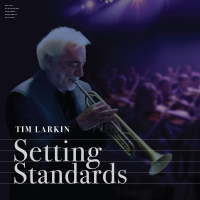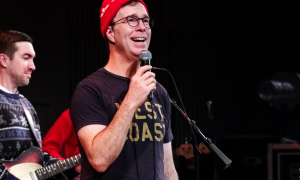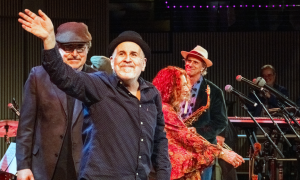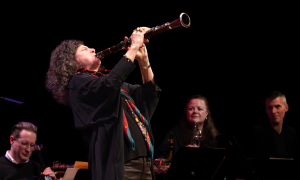Home » Jazz Articles » Live Review » Festival International de Musique Actuelle de Victoriaville 2007
Festival International de Musique Actuelle de Victoriaville 2007
On the jazzier side of things, the Corkestra delivered one of the best concerts of this year's edition. Compared to other orchestras incorporating improvisation, the eight-piece band led by Dutch pianist Cor Fuhler is based on a distinct conception of large group improvisation that reflects its leader's multi-sided practice. The Corkestra's music lies at the crossroads of multiple traditions and incorporates elements of these as varied as the swing of jazz and the textural concerns of sound-based improvisation into a cohesive and rich amalgam. Moreover, in concordance with the compositions' assumed melodic simplicity, each musician showed a lot of self-control, avoiding huge fuss and pyrotechnics. The result was very accessible, yet rich and sophisticated music.
On Friday evening, John Zorn performed a rare solo set at Cinéma Laurier. The core of the concert consisted of a 30-minute improvisation which marvelously illustrated who Zorn the saxophonist is. Using his vast array of extended techniques - circular breathing, overblowing, reed biting, etc. - he maintained a rapid flow of ideas from which one could discern the construction of something greater than the mere succession of odd sounds and juxtaposition of short vignettes. Of course, one could object that, except for the appearance of a Masada tune mid-way, there was little novelty compared to any solo set Zorn performed, say, 15 or 20 years ago. While totally valid, such a complaint would overlook too easily the mastery Zorn demonstrated and how unique his approach to the saxophone remains.
Still on the jazz front, this year's main event definitely was Anthony Braxton's return to FIMAV with two recent projects. On Sunday afternoon, the Diamond Curtain Wall Trio took the stage of the Colisée. The particularity of this project lies in the introduction of electronics into Braxton's music. In addition to Braxton himself on saxophones - sopranino, alto, baritone, bass and contrabass saxophones that is—Taylor Ho Bynum on multiple horns and Mary Halvorson on guitar, there was a laptop running SuperCollider software on stage. Despite the addition of electronics, the music was typically Braxtonian. The instrumentists played what one has grown to expect from Braxton's music: short phrases, more or less constant energy, little dynamics, etc. In this regard, Halvorson's contributions were wonderful both in execution and pertinence. Yet, because of the electronics, it also was typical in that it raised many questions. The electronics simply seemed to be a background layer of sound: there was no obvious interaction between the laptop and the other musicians nor did the sound produced by the saxophones, the horns and the guitar appear to be processed by the software. The electronics just seemed to be there! No matter how enjoyable the music was, what really stood out were the questions it raised.
On Sunday evening, it was time for the Anthony Braxton 12+1tet to perform. Those who were present in 2005 for the Sextet concert were in familiar territory as both projects appear to be based on a common set of principles: instant formation of subgroups (mainly duos and trios), introduction of auxiliary compositions (265, 69F, 67 among others on this occasion), superposition of compositions, etc. However, what made this concert a fascinating experience was that these ideas achieve their full potential in the context of the larger ensemble.
On the more electronic side of the spectrum, the Signal Quintet lived up to the expectations and reputation of the music Jason Kahn, Tomas Korber, Christian Weber, Günter Müller and Norbert Möslang have produced in the past years. Their opening 35-minute improvisation ranked among the festival's finest moments for its control and emphasis on sound research.
However, just like good music, less exciting adventurous music also ignores stylistic boundaries. On the rock front, the melodies and prog-rock elements Koenji Hyakkei's music is based on presented little interest even though their execution of these complex and difficult pieces deserve admiration. Quasar's ambitious project with electronicians Alexandre Burton and Julien Roy was also less than convincing. The use of electronic manipulations and live video revealed a laudable effort to open up the accepted framework of contemporary music. Unfortunately, the thinness of the ideas and mannerism of the performance could not hide how poor the musical proposition actually was.
This said, any festival featuring artists as varied as Marilyn Crispell—who played as part of a new quartet with Lotte Anker, Mark Helias and Andrew Cyrille that is likely to express its full potential once it has performed a few times—and Merzbow is bound to include disappointing moments. In the end, what matters is that interesting moments surpass weaker ones. It certainly was the case at this year's FIMAV.
Tags
Festival International de Musique Actuelle de Victoriaville
Live Reviews
Mathieu Belanger
United States
New York
New York City
PREVIOUS / NEXT
Support All About Jazz
 All About Jazz has been a pillar of jazz since 1995, championing it as an art form and, more importantly, supporting the musicians who make it. Our enduring commitment has made "AAJ" one of the most culturally important websites of its kind, read by hundreds of thousands of fans, musicians and industry figures every month.
All About Jazz has been a pillar of jazz since 1995, championing it as an art form and, more importantly, supporting the musicians who make it. Our enduring commitment has made "AAJ" one of the most culturally important websites of its kind, read by hundreds of thousands of fans, musicians and industry figures every month.
Go Ad Free!
To maintain our platform while developing new means to foster jazz discovery and connectivity, we need your help. You can become a sustaining member for as little as $20 and in return, we'll immediately hide those pesky ads plus provide access to future articles for a full year. This winning combination vastly improves your AAJ experience and allow us to vigorously build on the pioneering work we first started in 1995. So enjoy an ad-free AAJ experience and help us remain a positive beacon for jazz by making a donation today.Near
New York City Concerts
Dec
23
Tue


























